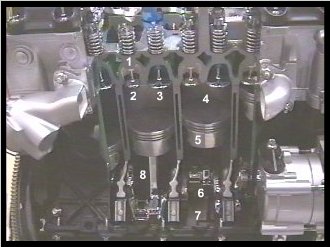Automotive Engines
Introduction to Car Engines
General:
 Car engines vary in design, but certain elements are common to all engines and are used for engine classification. Engines can be classified in several ways such as the number of cylinders, the geometry of the block, or type of ignition system used. The two major engine types in use are spark ignition (gasoline engine) and compression ignition (diesel engine) which use different types of fuel. The following are ways engines are classified.
Car engines vary in design, but certain elements are common to all engines and are used for engine classification. Engines can be classified in several ways such as the number of cylinders, the geometry of the block, or type of ignition system used. The two major engine types in use are spark ignition (gasoline engine) and compression ignition (diesel engine) which use different types of fuel. The following are ways engines are classified.
Fuel Burned:
Fuel burned provides a broad engine classification. Two types of fuel are in general use: gasoline and diesel oil. Gasoline car engines use spark ignition whereas diesel engines use compression ignition (no spark.) Alternate fuels such as liquefied petroleum gas (LP-gas), gasohol (90% gasoline, 10% alcohol), and pure alcohol are used in very limited situations.
Block Geometry:
There are four types of engine block geometry: V-type, inline, horizontally opposed and slant. Each refers to the orientation of the cylinders as viewed from the front or back of the engine. A V-type has two angled rows of cylinders, which form a “V.” An inline engine arranges the cylinders vertically in a row. The horizontally opposed engine has the cylinders horizontal and opposing each other. A slant design is one row of angled cylinders forming a half “V.” A slant block allows the hood line to be lower.
Number of Cylinders:
The number of cylinders is often used in combination with the engine block geometry (V6, slant four, inline four.) The number of cylinders is an indication of how smooth thecar engine will run. An eight-cylinder engine will run smoother than a four-cylinder engine since power strokes occur with greater frequency. The number of cylinders also contributes to power output; more cylinders, more power. However, this is not always a good indicator of power output. A turbocharged, four-cylinder engine can produce more power than a normally aspirated six-cylinder engine.
Camshaft Location:
There are two possible locations for the camshaft: in the cylinder head or in the engine block. Car engines with the camshaft in the cylinder head are labeled overhead cam (OHC) engines. A dual overhead cam (DOHC) engine uses two camshafts, one for the intake valves, the other for the exhaust valves. Single overhead cam (SOHC) engines use one cam for both sets of valves. Engines with the camshaft in the block, “cam-in-block”, use push rods to move the valves. The term overhead valve (OHV) refers to a cam-in-block engine. OHC engines have fewer valve train parts, which results in weight reduction. Valves can also be placed at an angle, which improves the air flow through the cylinder head ports.
Combustion Chamber:
Combustion chamber shape and type can be used to classify an engine. There are three shapes in use: hemispherical, wedge, and pancake. The hemispherical, also called “hemi-head,” is designed with the intake and exhaust valves angled and opposing each other (as viewed looking at the engine from front to back). This shape is most common. The wedge design has the valves side-by-side and slightly angled. The pancake design has the valves nearly vertical. Chamber type can be swirl, three-valve, or four-valve. A swirl chamber is designed to spin or twirl the air-fuel mixture as it enters. The three-valve design has two intake valves and one exhaust valve. The four-valve design has two valves for both intake and exhaust.
Ignition Type:
Two methods for igniting fuel are used, spark ignition and compression ignition. Gasoline car engines use spark ignition whereas diesel engines use compression ignition. This method compresses the air to the point where the resulting rise in temperature causes ignition to occur when diesel fuel is added.
Strokes per Cycle:
Strokes per cycle are the number of times the pistons travel up and down during one cycle. Modern engines have four strokes per cycle: intake, compression, power, and exhaust. Two-stroke engines are not used due to their poor power output at low rpm, motor oil mixed with the fuel, less fuel efficient, generate an unacceptable amount of pollution, and require more maintenance.
Cooling System:
Engines can be air-cooled or liquid-cooled. Air-cooled engines are used largely by motorcycles and piston powered aircraft. Liquid-cooled engines are the standard with most other vehicles. Air-cooled engines have large cooling fins surrounding the cylinder. Air moving across the fins carries away heat. Liquid-cooled engines have internal channels called water jackets in the cylinder block and cylinder head, through which coolant circulates, removing heat. In order to meet strict exhaust emissions standards, engine temperature must be maintained fairly constant. This is why most engines are liquid-cooled.